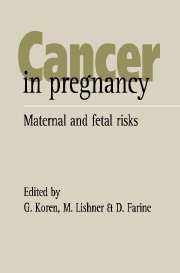Book contents
- Frontmatter
- Contents
- Preface
- List of contributors
- Part I Introduction
- Part II Specific tumors during pregnancy
- Part III Fetal effects of cancer and its treatment
- 16 Prenatal irradiation and cancer
- 17 Review of fetal effects of cancer chemotherapeutic agents
- 18 Fetal outcome following in utero exposure to cancer chemotherapy: the Toronto Study
- 19 Intrauterine causes of tumors in later life
- 20 Fetal tumors
- Index
17 - Review of fetal effects of cancer chemotherapeutic agents
from Part III - Fetal effects of cancer and its treatment
Published online by Cambridge University Press: 06 July 2010
- Frontmatter
- Contents
- Preface
- List of contributors
- Part I Introduction
- Part II Specific tumors during pregnancy
- Part III Fetal effects of cancer and its treatment
- 16 Prenatal irradiation and cancer
- 17 Review of fetal effects of cancer chemotherapeutic agents
- 18 Fetal outcome following in utero exposure to cancer chemotherapy: the Toronto Study
- 19 Intrauterine causes of tumors in later life
- 20 Fetal tumors
- Index
Summary
Cancer chemotherapeutic drugs are among the most potent teratogens known. Since they are administered at maximum tolerated dose, the risk of teratogenesis is great. In fact, Nicholson, in his seminal review of chemotherapy usage in pregnancy, estimated that the risk of malformations is 10% when cy to toxic drugs are administered in the first trimester in contrast to the 1–3% baseline.
Currently, there is very little information on the effects of chemotherapeutic treatment on the fetus; available information is based primarily on case reports. This paucity of data probably reflects a lack of experience in treating pregnant women and a tendency amongst oncologists to avoid chemotherapeutic treatment during pregnancy.
Most cases reported deal mainly with the presence or absence of morphological adverse effects. Commonly, neonates are described as “normal” without qualifying the term. For example, hematological values of neonates exposed to chemotherapeutic drugs are rarely reported. Occasionally details of laboratory results and physical exams are given, but long term follow-ups are seldom performed. Even basic details such as birth weight are often omitted.
Several chemotherapeutic drugs are teratogenic and mutagenic in laboratory animals; however, animal results cannot be directly extrapolated to humans. In animals, the fetus is most sensitive to malformations during the middle third of pregnancy. In humans this has not been shown. The risk of fetal malformation following chemotherapy in the second or third trimester is not greater than normal, but in the second and third trimester the risk of intrauterine growth retardation and premature labor is higher than normal.
- Type
- Chapter
- Information
- Cancer in PregnancyMaternal and Fetal Risks, pp. 168 - 180Publisher: Cambridge University PressPrint publication year: 1996
- 4
- Cited by

